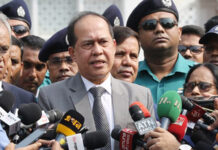‘Mega structures to worsen situation in city’
 Dhaka, Oct 4 (UNB) – Introducing non-motorised green transports, including bicycle and rickshaw, and ensuring safe footpaths for the pedestrians can minimise air pollution in Dhaka city and make it green and clean, says an environmental expert.
Dhaka, Oct 4 (UNB) – Introducing non-motorised green transports, including bicycle and rickshaw, and ensuring safe footpaths for the pedestrians can minimise air pollution in Dhaka city and make it green and clean, says an environmental expert.
“Rickshaw is very popular in Dhaka. People make 40 percent of their trips by rickshaw and cycle in the city,” Anumita Roy Chowdhury, executive director of the Delhi-based Centre for Science and Environment (CSE), told UNB on the sidelines of a conference in New Delhi last week.
Anumita said the government of Bangladesh frequently imposes restriction on rickshaws plying different streets of the city. “But, rickshaws should be protected on city streets and motorised vehicles like private car need to be restricted on many streets to make the city green.”
During her power-point presentation at the conference, Anumita said it is inherently believed that it is only the poor who walk on footpaths and ride cycles and rickshaws, but the fact is that the people of other classes also walk on footpaths. “Mumbai, Delhi, Kolkata and Dhaka account for a greater number of walk trips by all sections of people.”
“Although walking and rickshaw plying is of zero emission, there’s no adequate space for pedestrians on the city’s footpaths to walk and a limited access of rickshaws to city streets,” Anumita said.
About Bangladesh government’s transportation policy, the CSE executive director said the Bangladesh Road Transport Regulations and Rules 2012 requires ‘pedestrians to carry indicators, including reflector, lamp like that’. “These things need to be changed as people do not like that.”
Referring to the growing trend of building flyovers and expressways in the mega cities to ease traffic congestion, she said pedestrians ignore skywalks. “A study shows that about 81.4 percent of pedestrians say skywalks are unsafe,” she added.
A survey of St. Xavier College Mumbai says, “Their unnatural emptiness at off-peak hours makes them unsafe, especially for women with very few exit points.”
The government has already taken a number of mega projects like flyover and elevated expressway to ease traffic congestion in Dhaka city. However, urban planners have warned that such mega structures will worsen the situation in the capital.
“Flyovers or elevated expressways will intensify traffic problem in the capital,” says Prof Dr Sarwar Jahan, a teacher at Urban and Regional Planning Department at Buet.
People do not like walking on rigid lines, Anumita said adding that skywalks do not give the option of the shortest route possible.
“Flyover approach works for vehicles. Flyover (one-ways) increases distance of trips, driving, fuel use and pollution as passengers cannot get down from buses or cars on flyovers they want,” she said adding that urban design and safety are absolutely interlinked.
The environmentalist said a compact city should have shorter trip length, more walking and cycle share and less CO2 emissions.
Expressing her hope over the initiatives taken by the Bangladesh government to protect the environment in Dhaka city, Anumita said, “Dhaka has started reclaiming the public space although it has many problems like us.”
– See more at: http://unbconnect.com/green-dhaka/#&panel1-1
‘Mega structures to worsen situation in city’

Introducing non-motorised green transports, including bicycle and rickshaw, and ensuring safe footpaths for the pedestrians can minimise air pollution in Dhaka city and make it green and clean, says an environmental expert.
“Rickshaw is very popular in Dhaka. People make 40 percent of their trips by rickshaw and cycle in the city,” Anumita Roy Chowdhury, executive director of the Delhi-based Centre for Science and Environment (CSE), told UNB on the sidelines of a conference in New Delhi last week.
Anumita said the government of Bangladesh frequently imposes restriction on rickshaws plying different streets of the city. “But, rickshaws should be protected on city streets and motorised vehicles like private car need to be restricted on many streets to make the city green.”
During her power-point presentation at the conference, Anumita said it is inherently believed that it is only the poor who walk on footpaths and ride cycles and rickshaws, but the fact is that the people of other classes also walk on footpaths. “Mumbai, Delhi, Kolkata and Dhaka account for a greater number of walk trips by all sections of people.”
“Although walking and rickshaw plying is of zero emission, there’s no adequate space for pedestrians on the city’s footpaths to walk and a limited access of rickshaws to city streets,” Anumita said.
About Bangladesh government’s transportation policy, the CSE executive director said the Bangladesh Road Transport Regulations and Rules 2012 requires ‘pedestrians to carry indicators, including reflector, lamp like that’. “These things need to be changed as people do not like that.”
Referring to the growing trend of building flyovers and expressways in the mega cities to ease traffic congestion, she said pedestrians ignore skywalks. “A study shows that about 81.4 percent of pedestrians say skywalks are unsafe,” she added.
A survey of St. Xavier College Mumbai says, “Their unnatural emptiness at off-peak hours makes them unsafe, especially for women with very few exit points.”
The government has already taken a number of mega projects like flyover and elevated expressway to ease traffic congestion in Dhaka city. However, urban planners have warned that such mega structures will worsen the situation in the capital.
“Flyovers or elevated expressways will intensify traffic problem in the capital,” says Prof Dr Sarwar Jahan, a teacher at Urban and Regional Planning Department at Buet.
People do not like walking on rigid lines, Anumita said adding that skywalks do not give the option of the shortest route possible.
“Flyover approach works for vehicles. Flyover (one-ways) increases distance of trips, driving, fuel use and pollution as passengers cannot get down from buses or cars on flyovers they want,” she said adding that urban design and safety are absolutely interlinked.
The environmentalist said a compact city should have shorter trip length, more walking and cycle share and less CO2 emissions.
Expressing her hope over the initiatives taken by the Bangladesh government to protect the environment in Dhaka city, Anumita said, “Dhaka has started reclaiming the public space although it has many problems like us.”
Source: UNB Connect









